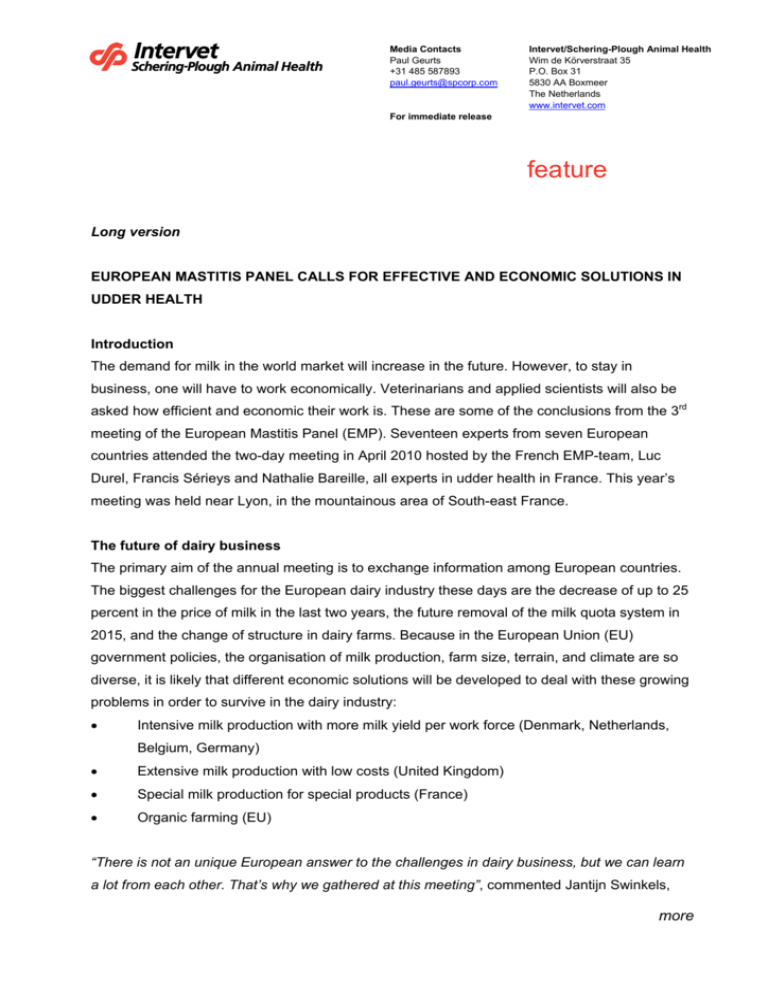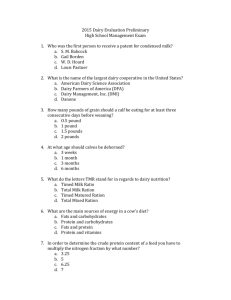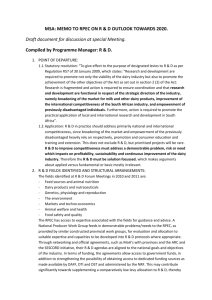feature - European Mastitis Panel
advertisement

Media Contacts Paul Geurts +31 485 587893 paul.geurts@spcorp.com Intervet/Schering-Plough Animal Health Wim de Körverstraat 35 P.O. Box 31 5830 AA Boxmeer The Netherlands www.intervet.com For immediate release feature Long version EUROPEAN MASTITIS PANEL CALLS FOR EFFECTIVE AND ECONOMIC SOLUTIONS IN UDDER HEALTH Introduction The demand for milk in the world market will increase in the future. However, to stay in business, one will have to work economically. Veterinarians and applied scientists will also be asked how efficient and economic their work is. These are some of the conclusions from the 3rd meeting of the European Mastitis Panel (EMP). Seventeen experts from seven European countries attended the two-day meeting in April 2010 hosted by the French EMP-team, Luc Durel, Francis Sérieys and Nathalie Bareille, all experts in udder health in France. This year’s meeting was held near Lyon, in the mountainous area of South-east France. The future of dairy business The primary aim of the annual meeting is to exchange information among European countries. The biggest challenges for the European dairy industry these days are the decrease of up to 25 percent in the price of milk in the last two years, the future removal of the milk quota system in 2015, and the change of structure in dairy farms. Because in the European Union (EU) government policies, the organisation of milk production, farm size, terrain, and climate are so diverse, it is likely that different economic solutions will be developed to deal with these growing problems in order to survive in the dairy industry: • Intensive milk production with more milk yield per work force (Denmark, Netherlands, Belgium, Germany) • Extensive milk production with low costs (United Kingdom) • Special milk production for special products (France) • Organic farming (EU) “There is not an unique European answer to the challenges in dairy business, but we can learn a lot from each other. That’s why we gathered at this meeting”, commented Jantijn Swinkels, more Page 2 of 8 DVM and Global Technical Director of Ruminants at Intervet/ Schering-Plough Animal Health, who organizes the meeting every year in a different European country. High milk price for special production The diversity of dairy production in the EU shows that there are numerous ways to survive. In France, for example, dairies with an average of 40 cows are widespread throughout the country, because the milk quota is linked to land size and cannot be traded on a quota market. Intensive farming is located in the North-west region of France where 50 % of the country’s milk is produced. The smallest farms and traditional local production of milk is found in the mountain areas. The dairy visited by the European group was specialized to produce high quality milk (AOC = Appelation d’Origine Controlée) for the production of raw milk cheese that is typical in that region (Rhône Alpes). Farmers receive a higher milk price (44 cents versus 28 cents for consumption milk) because they produce milk with an added value. In order to get the higher price they have to obey to strict rules, including low production (<5000 kg/year), cows fed with grass or hay only, no silage, and a low amount of concentrates. The price for AOC-milk bought by dairies varies regarding quality because certain contents would disturb the production of cheese (e.g. gas bubbles). They distinguish three different classes regarding the levels of Coli forms, butyric acids, Coagulase-positive Staphyloccoci, and Somatic Cell Count (SCC). The two main products are “Tome des Bauges AOC” and “Abondance AOC”. The cheese dairy has high quality standards for their products. They cooperate with veterinarians because their main concern is food-borne pathogens like Listeria, Staphylococcus aureus, E. coli and Salmonella. Research in times of empty cash boxes Not only dairy farmers have economic problems; researchers also face difficulties raising money for their projects. In France there are five different institutes dealing with mastitis research and these are not very connected to each other. In contrast, cooperation among institutes often found in small countries (such as the Netherlands) can save costs. In the United Kingdom different institutes apply for the funding from one foundation. So competition among the institutes serves to increase improvement and progress. Experts have pointed out that research does not necessarily have to be expensive. One should never forget the importance of practice and proportion in research. “It is difficult to raise money for projects in every country these days. We have to be creative, because innovation starts with new ideas,” Theo Lam from the Netherlands commented. more Page 3 of 8 Effective and economic dry cow treatment New results in the dry cow treatment were recently published by various study groups. The dry period is the optimal time to cure existing intramammary infection and to prevent new infection. However, the antibiotic treatment for drying off of all cows without exception is obsolete and additionally difficult to communicate to the consumer. Andrew Bradley, University of Nottingham (UK), applied a dry cow therapy selected at the herd and cow level: In herds with elevated bulk milk somatic cell count (SCC) the priority is antibiotic treatment of gram-positive bacteria. In herds with low bulk milk SCC the protection against gram-negative pathogen (main cause for new infection) is most important. The best and most economic treatment is the one that reduces the new infection rate during the dry period with minimal input. Nathalie Bareille, Veterinary School of Nantes (France), demonstrated the simulated computer model (Ecomast) that compares the cost of treatment to new infection rate and SCC in bulk tank. The model showed that farmers can save money and antibiotics when they follow the most economic strategies with selective antibiotic use. She advises not to use antibiotics in cows with a low SCC (<150.000 cells/ml) and low expected new infection rate (<15%) in a herd with a low bulk milk SCC (<180.000 cells/ml). The European Mastitis Panel has become a dedicated, well established group of mastitis experts and an important platform for discussion and networking in Europe. “Every year I listen, talk and discuss with my European colleagues”, one EMP-member pointed out, “Some ideas seem to be very traditional, others very innovative. In any case I take something home. This year it is the advancement of cooperation in my country.” Members are looking forward to the 4th annual meeting of the EMP that is scheduled for Italy in May 2011. The EMP-meeting is an initiative of and is supported by Intervet/Schering Plough Animal Health, a leading company in udder health solutions. For more information, see also www.EuropeanMastitisPanel.eu. more Page 4 of 8 Short version EUROPEAN MASTITIS PANEL CALLS FOR EFFECTIVE AND ECONOMIC SOLUTION IN UDDER HEALTH The demand for milk in the world will increase in the future. However, to stay in business, veterinarians and applied scientists need to add increased value for the farmer. The diversity of dairy production in the EU shows that there are numerous ways to survive.These are some of the conclusions from the 3rd meeting of the European Mastitis Panel (EMP). Seventeen experts from seven European countries attended the two day meeting, held near Lyon, in mountainous region of South-east France. The meeting was initiated by Jantijn Swinkels, Intervet/ ScheringPlough Animal Health, in close cooperation with Luc Durel, Francis Sérieys and Nathalie Bareille, all experts in udder health from France. Next year’s meeting will take place in Italy. Further information is presented on the EMP-web site: www.EuropeanMastitisPanel.eu. more Page 5 of 8 Member of the European Mastitis Panel during a farm visit in France Front row: left to right: Farmer Jean-Francois Domenge (F), Laura E. Partida (ES), Pierre Brouillet (F), Nathalie Bareille (F), Luc Durel (F), Martina Hoedemaker (D), Wilfried Wolter (D), Andrew Biggs (UK), Jantijn Swinkels (NL), Luc de Meulemeester (B), Hakan Landin (S) Back row: Andrew Bradley (UK), Sarne de Vliegher (B), Jorgen Katholm (DK), Theo Lam (NL), Francis Sérieys (F), Frederic Leboeuf (F), Volker Krömker (D) more Page 6 of 8 French European Mastitis Panel members Front row: left to right: Jean Francois Labbé, Nathalie Bareille, Pierre Brouillet Back row: Luc Durel, Francis Sérieys, Baptiste Lelyon more Page 7 of 8 Dual purpose Abondance cows in mountains of France more Page 8 of 8 Raw milk cheese “Tome de Bouche” a speciality of the region more







